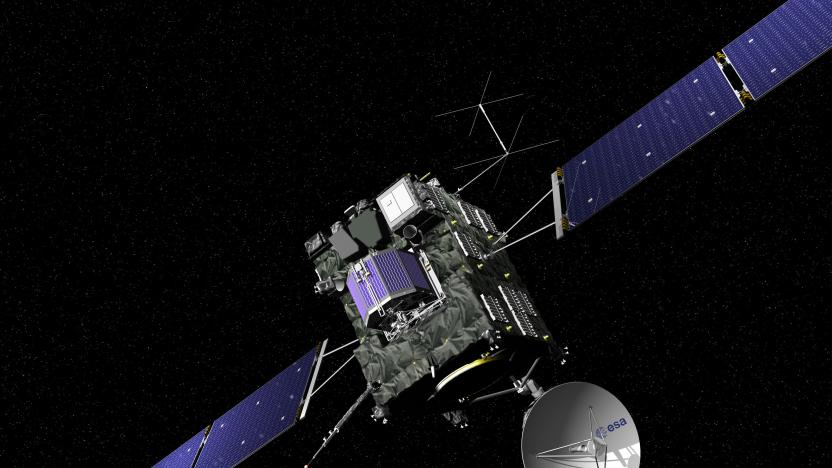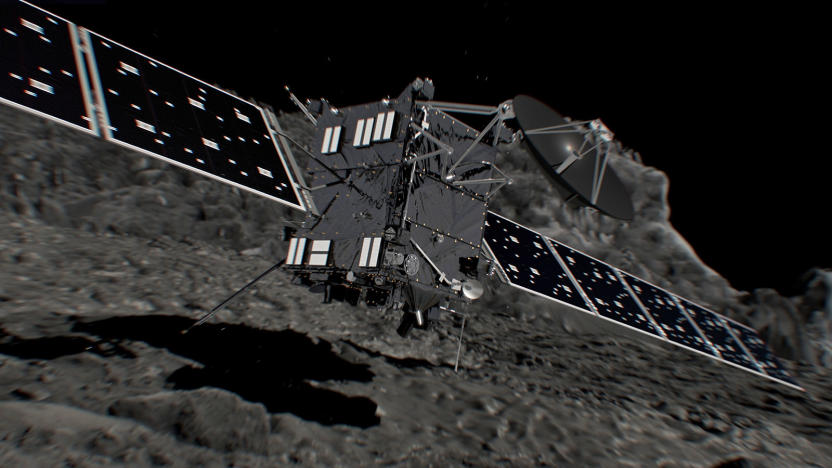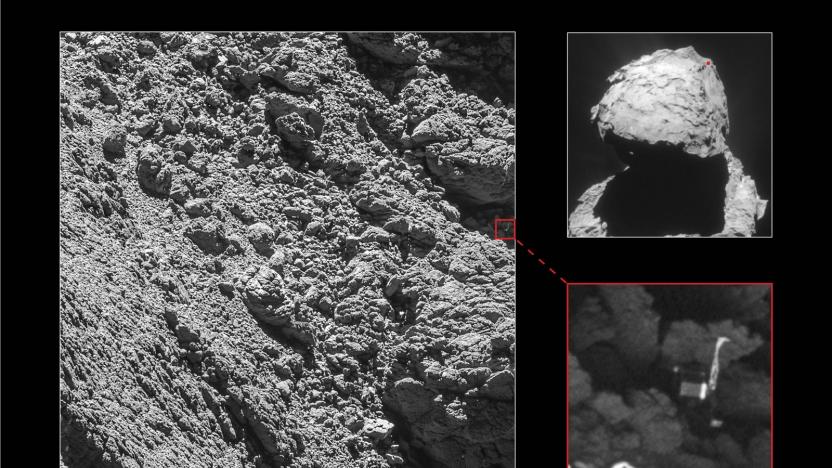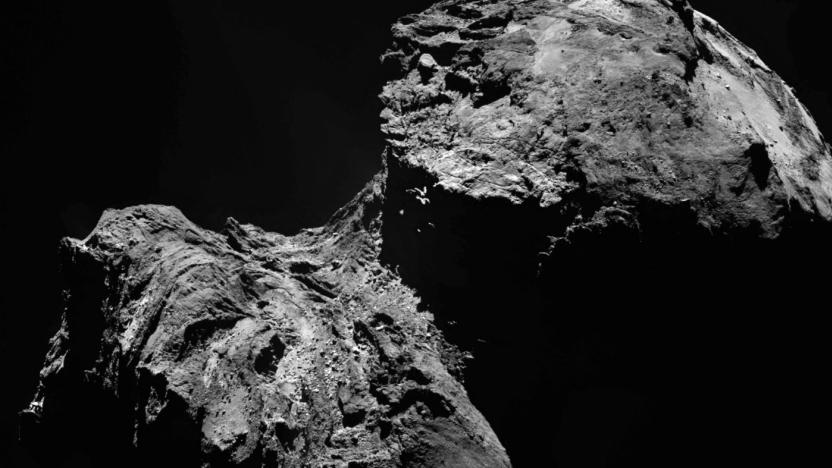comet67p
Latest

Rosetta probe's love affair with a comet ended predictably
Goodbye, Rosetta. After 12 years of getting up close and personal with Comet 67P, your service has come to an end. At approximately 7:19 am Eastern the spacecraft descended upon the comet one last time, snapping pictures and analyzing gases before crashing into its final resting place, according to NASA's Jet Propulsion Lab. Reuters reports that scientists in the control room clapped and hugged after screens indicated a loss of communication. Rosetta followed the comet around for over 6 billion kilometers since 2004. Shine on, you crazy diamond.

Watch the Rosetta probe fall into its death spiral this Friday
On September 30th, the European Space Agency's (ESA) Rosetta probe will cap off its 12-year career surveying Comet 67P (aka Churyumov-Gerasimenko) by slowly descending to its surface. There the spacecraft will join its lander Philae, given up for lost and recently re-found, before losing all power upon landing. You can watch Rosetta's last dance with its comet partner on NASA TV and elsewhere online, both broadcasting the probe's end with analysis and commentary on Friday from 6:15 AM until 8 AM ET.

Rosetta probe belatedly finds the Philae comet lander
You have to sympathize with the European Space Agency. It's less than a month away from crashing its Rosetta probe into its host comet, and it just found the Philae comet lander -- you know, the machine the mission team stopped trying to contact back in July. Photos show that the lander get stuck in a dark crack on the comet in a position that prevents it from getting sunlight, revealing exactly why it went to sleep after a mere three days of activity. The ESA has had a general idea of where Philae was, but the low-resolution photos available before now made it hard to pinpoint the machine's location.

Comet lander Philae says goodbye as communications are cut
Farewell Philae, it was a short but wild ride. In February, mission controllers said goodbye to the comet lander, but kept comms open with mother ship Rosetta on the slight chance it might wake up. "It's cold & dark on #67P ... but I won't give up just yet," Philae tweeted hopefully. However, controllers elected to cut Rosetta's "ESS" lander radio at 5AM ET today to preserve its precious remaining power.

Rosetta will crash into its comet and die on September 30th
Farewell, young spacecraft. The European Space Agency's Rosetta probe has been surveying Comet 67P (or Churyumov-Gerasimenko) for the past 12 years, and on September 30th it will crash into the space rock and end its mission. Rosetta is nearing the orbit of Jupiter, which means it's running short on solar power and bandwidth required to downlink necessary data.

The dark side of Rosetta's comet is icier than expected
The comet that the European Space Agency's Rosetta spacecraft has been chasing around the sun has a dark side. No, 67P isn't hiding any terrible secrets -- the southern hemisphere literally faces away from the sun during most of its 6.5-year-long solar orbit. Until recently, none of the cameras aboard Rosetta have been able to image it due to that utter lack of light, except for one -- the MIRO microwave instrument. NASA scientists behind the device have released a report on their observations, and lead author Mathieu Choukroun said "these unique data are telling us something very intriguing about the material just below its surface."

Philae comet lander goes silent once again
It looks like the Philae comet lander's moment in the sun was short-lived. Just weeks after getting back in touch, the European ground crew has once again lost contact with its celestial explorer -- the lander is sending irregular bursts of data, but that's about it. It's not clear as to what went wrong, but scientists suspect that comet gas or some other unexpected phenomenon moved Philae and blocked it from collecting that all-important, energy-giving sunlight. To make matters worse, one of its transmitters also appears to be out of commission.

Europe's Philae comet lander finally wakes up
After seven months of not-so-voluntary deep sleep, the comet lander Philae has finally woken up in earnest. The European Space Agency got in contact with its explorer for 85 precious seconds late on June 13th, receiving 300-plus data packets that shed light on what happened following the machine's bumpy touchdown. As it turns out, Philae came back to life at least temporarily during its forced hibernation -- it just couldn't get back in touch with its Rosetta host ship and thus the ground crew.

Comet lander offers fresh insights about planet formation
The Philae comet lander might be slumbering, but it can still teach you a thing or two about the nature of celestial bodies. European Space Agency researchers have compared Philae's data against the more distant Rosetta probe, and they've discovered that Comet 67P/Churyumov-Gerasimenko isn't magnetized. If it's representative of other comets, that suggests that magnetic fields aren't nearly as important in planetary formation as scientists thought -- these clumps of dust are forming simply through collisions, and magnetism only factors in when there's enough material for gravity to take over. It could take a long while before there's stronger proof of that theory, but it's already clear that some previously-held beliefs about comets were off the mark.

Philae comet lander may wake up as early as this week
After a few months of slumber due to a lack of sunlight, the Philae comet lander might be close to waking up. It's receiving enough sun now that the Rosetta probe will attempt to resume contact between March 12th and 20th. If communication is successful, the next step will be to decide what research Philae can handle -- it'll conduct long-term studies if it has enough power to run during the comet's night cycle, but it might be limited to a handful of tests if it can only stay active in the daytime. There's no guarantee that the lander will answer (it's only in sunlight for an estimated 1.3 hours every comet day), but scientists vow to give it another try if they only get silence.

The Big Picture: Rosetta gets up close and personal with a comet
Thought the Rosetta probe's earlier comet snapshots were special? They don't have a patch on its latest photo session. The ESA spacecraft went on its first dedicated close flyby of Comet 67P/Churyumov-Gerasimenko this weekend, and the images it captured have revealed a whole new level of detail. The picture you see above was taken a mere 5.5 miles above the comet's surface, and shows how the landscape varies wildly over short distances. You'll see everything from relatively smooth plains to fractured hills in a span of just 0.8 miles -- unlike a planet, there's no significant gravity (or many other factors, for that matter) to shape the terrain. Be sure to savor this imagery while you can, by the way. Rosetta's next goal is to get a long-range shot from 158 miles out, so you won't be getting more close-ups any time soon. [Image credit: ESA/Rosetta/NAVCAM]




